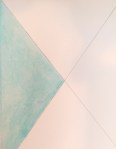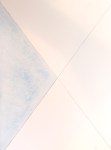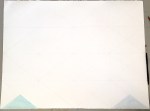In her book the life-changing magic of tidying up: the Japanese art of decluttering and organizing Marie Kondo offers joy as the principal criterion that we should use as we approach the process of organizing our living spaces. This is a key insight that I like and it drew me to read the book. The book is all about the process of keeping spaces clutter free. She affirms that when living spaces are occupied by objects that bring us joy, a lifestyle can be created that is more inspiring, motivating and enjoyable.
I mention this method presented by Marie Kondo, because it happens to be one that I am currently reading. I am using her method to get organized. I found her take on this whole matter of keeping a pleasant living space to be, just that, pleasant. It also fits nicely with the theme of creativity as a work process.
My artwork is in some respect all about order. Through the development of the elements of form and color, my aim is to to create harmony and beauty. The elements I use include geometry, abstraction and living and growing patterns in nature. When I work, it is not unusual for me to be joyful and completely engrossed in the artwork’s unfolding.
This new painting (see image below) is composed of a series of lines and triangular forms that are arranged in an orderly design.
Many layers still remain to be developed in the composition. I used the lighter palette color to create buoyant and light filled watercolor washes.
I am using Kremer Pigmente’s pigments and paint. Kremer’s watercolors – their pigment selections – are beautiful, and I am pleased with the medium and the results thus far. I am specifically enjoying the fluid and smooth finish and ease of placement of the pigments onto the paper. As for the overall artwork’s design, I know that the ordered pattern holds classical elements that allow for a constructive purposefulness to unfold.
It truly is a joy to work with good materials, in this case: Kremer watercolors, Arches watercolor paper and a modest set of Kolinsky paint brushes. I usually use a 4H graphite pencil for all my line work. Over time, I have built-up a collection of geometric-architectural measuring forms, templates, rulers and compasseses. As I just mentioned, these materials make the work process enjoyable, dependable and effective.
I am more aware of the natural reciprocity that emerges between the artist and the materials and instruments used. This is especially true with the brushwork and drawing process. It includes planning, measuring and crafting of a design on the blank surface – as an open space. Through this process a new composition is designed.
Coming back to the description by Marie Kondo, influenced by the Japanese art of Feng Shui, and her approach towards organizing living spaces, I was struck by an insight she shared. She noted that Japanese furniture and clothing were interlinked in the details of their designs historically. The art of crafting chests and drawers for storing properly folded Kimonos does reveal, as she suggests, a fascinating cultural and historical insight into the care given to a design for the purpose needed in the living space.
It is remarkable as a cultural development of sensibility towards working with materials. It is accompanied by a form of folding that prescribed specific folds and space usage. Interestingly, this traditional form of folding was recently used by LACMA to store its Kimono collection. It was re-discovered in their more modern perspective as the most space effective storage solution.
Folding is really a form of dialogue with our wardrobe. Japanese traditional clothing, kimono and yukata, were always folded into rectangles to fit perfectly into drawers designed to their uniform dimensions. I don’t think there is any other culture in the world where storage units and clothing were matched so precisely. I think Japanese people quickly grasp the pleasure that comes from folding clothes.
After reading her book, I began the process of addressing the folding of my own clothing based on her method. The folding technique, which I initially was going to skim over, I chose to give it another look and see what I could find as a youtube video on this approach. That’s when I came across this article about LACMA’s Kimonos. Maybe there was something more to this after all, more than just a quirky way to fold clothes in a drawer, was my open minded decision… And, yes, it does considerably increase the space capacity for storage of my armoires. I share this for those of you who want a new take on organizational strategies.
This observation by the author, about the kimonos and chest of drawers, reminds me once again of how the work process (any kind of work,) has the potential to open up a creative dimension that will benefit the designs we fashion. For me, it is also a reminder that a sensibility is acquired and developed through experience. This occurs mostly over time while working on the task at hand, especially if we allow ourselves to receive the creative dimension it offers into our lives.














Very nice and comprehensive writing, Lorien. I really like the new artwork that you’re engaged with right now. The subtlety and lightness of color is nice to see iwirh these natural pigments and your geometric/abstract designs.
LikeLike
I’ll be starting on the next layer in the composition and will write about it again. It will be interesting to look at these artworks once a series builds up. Thanks, Daniel. Great feedback!
LikeLike